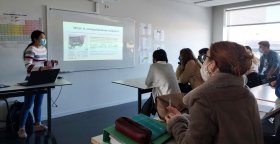Fei Wang


PhD Programme: Chemical Science and Technology
Research group: QCG – Quantum Chemistry Group
Supervisors: Cornelis de Graaf & Josep Maria Poblet Rius
Bio
Fei Wang obtained her Bachelor degree in Applied Chemistry and Master degree in Physical Chemistry from Yanbian University, one of the key universities of the P.R. of China. During the postgraduate program, she has been involved in theoretical design optoelectronic sensor by Gaussian 09 package with the thesis titled “Theoretical study on the optical response behavior to hydrogen chloride gas of a series of Schiff-base-based star-shaped structures” as the first author in Journal of Molecular Modeling. After the first section work, she noticed that the luminescence mechanism of the third generation luminescent materials-thermal delayed fluorescence (TADF) materials is not systematically analyzed. Therefore, the authors calculated the parameters closely related to the luminescent properties of TADF and analyzed the reasons for distinct luminescent efficiency of two similar structures to explore the key factors determining the performance of TADF.
Project: Computational Analysis of the Catalytic and Ferroelectric Properties of Polyoxometalates
Polyoxometalates, or POMs in short, are a type of molecular oxides that have great versatility in terms of their composition, electronic structure, charge distribution and applications. Among the applications, its catalytic, photocatalytic and electrocatalytic properties stand out. This thesis is divided into two distinct parts. The first focuses on the use of polyoxometalates in electrocatalysis and photocatalysis, while the second part reports the characterization of ferroelectricity, a property that has recently been detected in some polyoxometalate salts. Using various theoretical methods, including classical molecular dynamics MD methods, DFT methods and ab initio CASSCF/CASPT2 methods, the redox behaviors of a series of POMs in the electro- and photocatalytic transformation reactions of carbon dioxide and carbon monoxide. The reaction mechanisms and the role played by POMs as catalysts have been analyzed in detail. It has been a challenge to calculate the ferroelectric polarization for a system as large and complex as a polyoxometalate salt. Firstly, this property was analyzed in a much simpler system such as a hybrid organic-inorganic perovskite (HOIP). Then, with the experience gained, the ferroelectric polarization in Preyssler [XP5W30O110]q- anions was analyzed, in which the origin of the polarization was determined by decomposing the ferroelectric effect into three contributions.
Open Access publications
- Wang, F., Gao, H., de Graaf, C. et al. Switchable Rashba anisotropy in layered hybrid organic-inorganic perovskite by hybrid improper ferroelectricity. npj Comput Mater 6, 183 (2020). View full-text
- Fei Wang, Zhongling Lang, Likai Yan, Alessandro Stroppa, Josep M. Poblet, and Coen de Graaf , "Density functional theory study of single-molecule ferroelectricity in Preyssler-type polyoxometalates", APL Materials 9, 021109 (2021). View full-text
- PHD THESIS: Computational Analysis of the Catalytic and Ferroelectric Properties of Polyoxometalates
International secondments
- Consiglio Nazionale delle Ricerche, Istituto SPIN, Italy. 1,5 months (2019).
Outreach activities
- Science Week 2021, Escola Internacional del Camp: “Computational science”.



